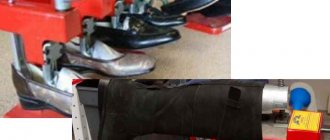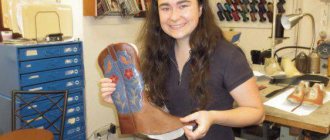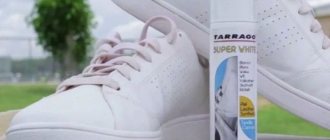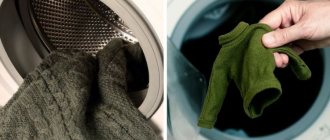Special means for stretching
The easiest way to increase the size of your boots is to purchase a special aerosol. It is applied to the area of the shoe where the product “sits” most tightly on the foot.
After applying the spray, you need to walk around in boots for at least 30 minutes. When stretching out a new thing, try not to stay in one place, but to move, this way you will achieve results faster.
Newspapers
- Stretching in this way does not cause damage to the shoes. You will need a large amount of damp newspaper, which is filled with the product, after which the paper is left inside for 12 hours.
- Then you need to put on thick socks (if possible, several pairs at once) and walk in shoes for as long as possible.
- This process must be repeated until the product reaches the desired size.
Freezer
Using cold, you can get the desired size within a day. To do this, pour water into a double plastic bag and tie it tightly. The presence of air in the bag is not allowed.
The “bubble” should be carefully placed inside the shoe and placed in the freezer for 10–12 hours. The boots are then removed from the freezing compartment and “thawed” at room temperature.
Thermal impact
You can also increase the size by heating the product. You need to put on several pairs of thick socks, and then put on tight boots.
Turn on the hair dryer at high temperature and direct the air flow to the desired area. You can warm up the same place for no more than 1 minute. Then turn off the device and stay in your shoes until they cool down.
With the right approach, stretching boots at home will not be difficult.
How to stretch patent leather shoes
This case is the most difficult, since the varnish coating on the shoes does not allow the leather backing to stretch, and under aggressive influence the varnish cracks and loses its shine. Therefore, stretching such shoes even by half a size is almost impossible; the maximum that can be done is to soften the inner surface of the shoes so that they stop rubbing.
Method 1 – sock + alcohol
First, try the classic method - wearing tight shoes on socks for 2-3 days. To speed up the process, you can lightly moisten your socks with a solution of water and alcohol (2:1) and do not remove your shoes until they are completely dry.
Keep in mind: under no circumstances should you heat the varnish with a hairdryer or hot water, otherwise dull spots and mesh cracks cannot be avoided. You should not warm up patent leather shoes even from the inside; in 80 cases out of 100, the polish loses its properties, becomes brittle and dull.
Method 2 – rich cream + pad
The most effective way is to use fatty cream, Vaseline or any natural oil and a special pad. If you are afraid of stains, you can replace fatty substances with a special stretching foam for patent leather shoes. Treat critical areas (heel, toe, places where corns form) more thoroughly and lightly knead with your hands to speed up the stretching process
After this, put the shoes on a special last for at least a day, and if necessary, repeat the procedure. All this time, shoes should be kept away from sunlight, radiators and any heating devices.
How to stretch boot tops at home
Stretching the boot is a labor-intensive and risky process. To avoid damaging the product, you should not try to stretch it in cases where:
- the zipper is only zipped halfway;
- the shoes are made of leatherette.
In other cases, even if the lightning does not converge by a couple of centimeters, you can influence this area yourself. Let's look at how to stretch the boot tops at home using improvised means.
How to stretch leatherette shoes
It is better to immediately take tight shoes made of artificial leather to the store or give them to friends, because they practically cannot be stretched. Leatherette does not have the softness and pliability of natural leather, so it is too difficult to change it “in the image and likeness” of natural leather. But you can try one of two options.
Option 1 – thick sock
A really effective way to increase the size of leatherette shoes is to wear artificial “suede” or “leather” shoes around the house with a warm sock for several days. To enhance the effect, the internal surfaces can be lubricated with Vaseline. Such tricks will not allow you to make shoes a size larger, but they will help wayward shoes fit exactly on your feet.
Option 2 – paraffin
If your shoes are really dear to you, but they rub or feel too tight when instep, you can try to soften the leatherette a little with paraffin. Before the procedure, dry your shoes and warm them thoroughly with a hairdryer. Then take a paraffin candle, heat it a little over the fire and with the soft side treat the problem areas from the inside (most often the heel, seams, side surfaces). When the paraffin has hardened, put on your wayward shoes with a warm sock and walk around the house for a day or two.
After this procedure, the artificial material should expand in width, and the rough areas will stop pressing due to the slippery paraffin coating. At the end of breaking in, carefully scrape off the remaining paraffin and wipe the shoes with a cotton pad with Vaseline.
By the way, there is another popular way to stretch leatherette shoes - treatment with kerosene. But we doubt its effectiveness, so we strongly do not recommend conducting risky experiments.
Stretching with an iron
To successfully complete the task, you must act carefully, without making sudden movements, and follow the following sequence of work:
- Unfasten the boot and lay it on a flat surface.
- Preheat the iron to medium temperature and steam the shoes through a wet cloth.
- When the material becomes soft, stretch it to the required measurements, noted in advance.
Once the desired size is obtained, the boots are stuffed with paper and allowed to dry at room temperature. If it was not possible to achieve the desired result the first time, the procedure must be repeated.
Glass container and pencils
Shoes should be wetted in problem areas with hot water, then a glass container filled with water at a lower temperature should be placed inside the boot. After this, pencils are alternately inserted between the container and the boot until there is no free space left, and set aside until completely dry.
Using these methods, you can achieve the desired result, and the boots will fasten into the boot without much effort.
Vegetable oil heated in a water bath will help stretch the shoes.
New leather shoes cause discomfort when worn and often damage the skin. To avoid this, it is necessary to stretch the product before use. Let's look at how to wear leather boots correctly:
- Put on your boots and walk around the room every day. If you experience any discomfort, take off your shoes immediately.
- Moisten the product with boiling water to make the leather soft and elastic. Then put on your shoes and walk around the room. Remember, boots are stretched until completely dry; it is not advisable to remove them before.
- Heat vegetable oil in a water bath and wipe the surface of the shoes with it using a foam sponge. After impregnation, the boots must be put on and left in place for an hour and a half, repeating the treatment every 30 minutes. After the shoes have stretched, the oil is thoroughly washed off with water.
Breaking in leather boots is easy. This material is easily stretchable, and you can easily get rid of the discomfort when wearing such shoes.
5 proven ways to stretch leather shoes
Before proceeding with size increase procedures, visually determine the type of skin. If it is thin and soft, a light touch will be enough. But for rougher shoe leather, almost any method is good - this natural material very steadfastly endures any “hardships of life.”
Method 1 – wool sock
So, let's start with the gentlest possible approach - the usual grandma's breaking in unsuitable shoes on the sock. It’s simple: wear tight shoes on the warmest possible (terry or woolen) sock and walk around the apartment for a couple of hours, taking them off from time to time so as not to put pressure on your feet. You shouldn't expect quick results, but your favorite shoes won't deform and will fit your feet perfectly.
Method 2 – alcohol
If the usual stretching did not work or you were unable to go out for the prescribed two hours, you can speed up the procedure a little with the help of an alcohol solution. To prepare it, mix medical alcohol and plain water in a 1:1 ratio, pour it into a spray bottle and treat the inside surface of the shoe. Let it soak in the solution a little, and then put it on a warm sock and wear it for half an hour.
Any remaining moisture should dry naturally away from direct sunlight. The alcohol solution can be replaced with household alcohol-containing window cleaner, cologne or eau de toilette.
Alcohol dries out the skin, so after the shoes are dry, treat them with slightly warmed Vaseline or moisturize them with any cream.
Method 3 – Vaseline and castor oil
If you need to stretch expensive shoes a size or more, use a tandem of Vaseline or castor oil and a special shoe last. Generously coat the inside of the shoe with Vaseline and place a shoe last purchased at a special store there for a day. It will help to gently expand the skin without deforming its original shape. The next day, clean off any remaining Vaseline with a soft cotton pad.
Method 4 – soaking in boiling water
This emergency method is suitable for more undemanding boots and boots made of thick leather. Pour hot water inside the boots for 30 seconds, pour them out and immediately put them on a pair of thick socks. If this kind of “soaking” seems too daring for you, you can simply wrap the unsuitable pair in an old T-shirt soaked in hot water.
But before walking the reanimated all-terrain vehicles, dry them thoroughly at room temperature without using a hairdryer.
Method 5 – freezing
There is another method exclusively for thick boots - stretching using the “cowboy” method or freezing. Both are based on physical processes. In the first case, the “active substance” is ordinary water, which, when frozen, becomes a natural stretcher. But don’t pour it directly into your shoes; it’s better to place a thin plastic bag in the middle and pour water into it. To avoid deformation, leave the package slightly open.
In the second case, pre-soaked grain is poured into the boots, which swells, thereby stretching the leather. The main thing is not to forget about it, otherwise on the second day you will be able to collect waste and wonder where such a specific smell came from in the apartment.
It is best to carry out the procedure at night, so that in the morning you can take out the “frozen” boots and let them thaw at room temperature. Remove the bags and leave the shoes in a cool, dark place all day. In the evening, you can try them on and gently lubricate them with natural Vaseline to restore the natural balance of the skin.
Note: after each aggressive influence, leather shoes should be carefully dried and treated with any natural, odorless oil of vegetable origin or a specialized impregnation. This will extend its service life and maintain a beautiful appearance.
How to stretch faux leather boots at home
Shoes made of artificial leather cannot be stretched, and when trying to increase the size, the material deteriorates. Therefore, you won’t be able to stretch the boots too much; you can only soften them slightly in the following ways:
- Use castor oil, whose properties are similar to those of special sprays. Apply a small amount of product to the required areas and wear the product for as long as possible.
- If the shoe puts pressure on the toe or heel, lubricate this area with a 13% vinegar solution. Then put on the product and wear it until it dries.
These methods, at least slightly, help cope with the problem and partially eliminate the inconvenience.
How much does it cost in the workshop if they press in length or width?
In shoe studios you can produce any kind. Specialists will take into account the characteristics of the material
No master will undertake stretching a product made of artificial leather or rubber.
The work of a master will cost more than if the procedure was carried out independently. However, if a specialist takes on the job, he will guarantee you the desired result.
Information.
To change the size of shoes, craftsmen use modern and delicate processing methods. The shoe workshop uses a full range of measures to stretch products in length and width.
How to stretch rubber shoes at home
Is it possible to stretch rubber boots yourself and how to do it? First of all, you need to understand that rubber is plastic and practically cannot be stretched. If you apply a lot of force, it will simply break.
Only boots made of PVC material can be stretched.
How to stretch rubber shoes yourself? Follow this sequence of actions:
- Pour boiling water inside the boots and leave for 30 minutes.
- Put on thick socks and, after draining the water from inside, quickly put on your shoes.
- Soak your feet in a basin of cold water and stretch your shoes for 20-30 minutes, pushing into tight areas as hard as you can.
By following the recommendations given, you can achieve the desired result yourself, without the services of a specialist. And in order not to look for the answer to the question “how to stretch boots,” you need to carefully try on shoes when purchasing.
Source
How to stretch leather or suede shoes
Illustration: Lifehacker
Leather and suede are pliable, elastic materials, especially when exposed to heat.
- Place the shoes in a bathtub or sink and pour boiling water over the inside. It is enough to just fill the insides of the product for a couple of seconds and immediately pour out the hot water. Blot the moisture, wait for the shoes to cool a little, and put them on your feet. Preferably over socks to avoid getting burned.
- If you are afraid of getting your shoes wet, do the same, first placing a bag inside each shoe so that the boiling water and the lining do not touch.
- Not only boiling water will be effective, but also ice. Fill two bags a quarter full with water, tie them and drop each into your shoe. Place the structure in the freezer and remove it when everything is completely frozen. After the ice has melted, remove it from your shoes. This procedure is suitable for a strong, undemanding couple: not every material will withstand the cold test.
- Moisten the inside of the shoes with alcohol or vodka, put on a pair and wear for several hours. Such an impact will help soften the material and adjust the shoes to the size of your feet. But remember: alcohol is quite aggressive, so first test the color fastness on an inconspicuous area.
The same methods apply to fur-lined winter shoes. Just don’t get the insides of your shoes or boots too wet. Well, you will need to dry your shoes carefully.
We solve all problems with rubber boots: cracks, stretching, slipping, painting.
Nothing lasts forever and rubber shoes, no matter how strong they are, also wear out and deteriorate like any other. But what if you can delay this and resuscitate your favorite rubber boots? What if they can be sealed and their former waterproofness restored? Or paint it and be fashionable again in rainy weather? I have collected many different methods that will help extend the life of rubber boots or other rubber products (for example, an inflatable boat), and will also help eliminate minor problems such as slipping soles. Choose the ones that suit you and be glad that going to the store and spending money are postponed.
When does it become necessary to stretch rubber boots and is it even possible to do this?
For example, if you did not read my last article about choosing the right rubber boots and bought shoes in a smaller size. Maybe the shoes were given to you as a gift or they were “inherited” and are not the size that you wear. Maybe due to deteriorating leg health (swelling, protruding bones).
You can stretch rubber boots , but not all of them, only those made of PVC (polyvinyl chloride). It is impossible to do such a procedure with rubber ones (they were all like that in Soviet times) - they are not elastic enough and will simply burst during the stretching process. PVC, on the other hand, is capable of changing its shape when heated and then maintaining it, hardening again when cooling. So if you have rubber ones, just buy a new pair.
- This should be written on them (usually on the sole).
- Or check it yourself: in an inconspicuous place, apply a hot needle to the material (heat it with a lighter). If the “rubber” melts, it’s definitely PVC.
How to stretch patent leather shoes
Illustration: Lifehacker
It is more difficult to stretch patent leather shoes because there is a risk of damaging the top coating: it can crack and lose its shine. You can painlessly enlarge your shoes if there is soft and thin leather (natural or artificial) under the varnish. Is your couple like this? Then let's get down to business!
- Mix alcohol and water in a 2:1 ratio and wet your socks with the resulting solution. Now put them on and put tight shoes on top. You should walk in your shoes for about an hour or two until the socks are completely dry.
- Treat the inside surface of the shoe with Vaseline or cream, paying special attention to the dense parts: the toe and heel. Then you need to insert the lasts into the shoes (if you have them) or, as usual, put the shoes on with thick socks.
Methods for stretching rubber boots (made of PVC).
Keep in mind that you can stretch it by 1-2 sizes, no more . And this greatly depends on the composition of this PVC, how much plasticizer it contains, and how much the thin knitted mesh on its inner side can stretch. If the boots are more than 2 sizes too small, there is only one way - to the store for a new pair.
The first method of stretching rubber boots.
- very hot water into them . There are different opinions about the temperature of the water: some write to pour boiling water right away, others say that the water needs to be heated by 70-80 degrees. I would first pour in just hot water - about 70 degrees (but no less, otherwise there will be no effect), and after the boot warms up - almost boiling water at 95 degrees, to avoid a sharp temperature change and damage to the shoes.
- Let the boots sit for half an hour. If the water cools down quickly, add boiling water.
- Put on thick woolen socks (or 2-3 pairs if you need to stretch a lot), empty the water from your shoes and immediately put on hot, damp boots. Be careful - don't get burned! Also, first put on thick cloth gloves to protect your hands.
- If you need to stretch more, rock back and forth in your boots, rolling your foot from toe to heel and back.
- Wiggle your toes so they have more room later. Walk around with your shoes on until the boots cool down and secure the desired shape.
- Sometimes it is recommended that immediately after putting on boots, stand in a basin (bath) with cold water in them so that fastening occurs faster, but remember that high contrasts are not always good and can lead to damage!
Pros: Stretching occurs immediately according to the shape of your leg + healing sauna effect for the legs. Cons: Not everyone likes foot steaming. It’s not always possible/time/desire to wear rubber boots, especially damp ones.
Second rubber boot resuscitation method.
Buy shoe stretchers , they are sold in shoe stores (can also be found on the Internet). The boot is heated over steam for a long time until it becomes soft. You can pour boiling water into the boot and wait for the material to soften. After this, you insert the stretchers, adjust to your size and leave the boot until it cools completely.
Pros: No need to wear boots, endure heat and discomfort for some time. Cons: you need to buy stretchers if you don’t have them. If you adjust them incorrectly, you may have to repeat the procedure more than once.
Is it possible to stretch
If your boots have become too small, you can stretch them to the required size at home - there are a lot of techniques.
Important!
However, it is worth considering the characteristics of the material from which the product is made when choosing one method or another.
Leather is a material that dries out over time. You can stretch it by 1 size using natural and artificial materials (steam, ice, damp newspapers).
Winter with fur
Changing the size of winter boots is not easy, since the inside is lined with fur, and not all processing options will have a positive effect on the condition of the products. Using thick socks and heating with a hairdryer will quickly help solve the problem:
In addition, you can use professional products (sprays, stretchers) to stretch winter shoes.
Stuff your shoes with paper in advance. Apply the products on top of the boots.
Apply the product to those areas that cause severe discomfort and leave overnight. A few procedures are enough to stretch the shoes to the desired size.
Rubber and polyurethane
Rubber boots and shoes made of polyurethane are most in demand in recent years. You can change the size of such shoes only if they contain polyvinyl chloride. You can check whether the product is subject to stretching in the following way: touch the product with a hot needle. If the material melts, the shoe size can be changed.
Use the following methods to finish your rubber boots to the desired shape:
- Fill the product with boiling water;
- Wait until the material becomes softer;
- Put on thick socks and drain the water from your boots;
- Put on the product and stand in a container of cold water.
Nubuck
Nubuck is a material that requires delicate care. you need to be very careful. The following methods will help you with this:
Rubber boots slip. How to solve a problem?
If your sole tries to slide into the ditch, it means that it is too smooth - there is no grip on the ice surface. Or your sole is too hard ; at low temperatures it hardens even more, which, firstly, limits the maneuverability and flexibility of the foot to maintain balance, and secondly, forms a film of water between the sole and the ice, due to which sliding occurs. The following techniques will help correct the situation:
Unreliable methods that are best abandoned immediately or used temporarily when there is nothing else at hand.
Effective methods for improving anti-slip soles.
For ordinary streets they are not so spiky, don’t worry)
Felt, linen, flannel or sandpaper. A good option is to glue pieces of thick felt to the sole. But this is not always convenient, because this may make it inconvenient to walk: the evenness of the sole is disrupted. This requires skill. Flannel or linen in this case will be a good replacement for felt. As for the sandpaper , it must be fabric-based , but even then it wears off quite quickly and has to be changed often .
Capron. Old nylon tights are melted over a fire and liquid drops are applied to the sole so that they collect in small tubercles.
Sand on the sole will prevent slipping on ice. Therefore, it seems to me that the option of immediately applying glue to the sole and immediately sprinkling it with sand (which you can buy at a construction site or ask a janitor) will be the best option for solving the problem of slipping in winter. After applying the sand, you need to wait a day until the glue sets. If the sand wears off, just repeat this simple procedure. Sometimes the sole is even deliberately melted a little in a frying pan or baking sheet, and then placed on a sandy surface. The sand is imprinted into the sole, providing a long-lasting effect. But there is a risk of ruining the boot, so you have to do it skillfully.
Tips before stretching shoes
- If you have never stretched shoes, then practice first on an old pair that you don’t mind ruining.
- Do not heat shoes with plastic elements. Hot air can cause them to melt.
- After stretching, the skin loses its natural oils and becomes drier and brittle, especially when treated with heat and alcohol. After stretching, apply a special conditioner to your shoes or moisturize them with any cream.
- Do not rush to stretch your shoes with aggressive means. If new shoes are a little tight, it is better to stretch them while wearing them. It is quite possible that it will be enough to endure a couple of days - and the model will sit on the leg like a cast one.
- It is better to take expensive shoes to a good workshop. At home there is a risk of spoiling it.
All these methods have been developed over decades, so there is no doubt about their effectiveness. Just don't compare expensive Italian shoes with all-terrain shoes bought on sale. It is quite possible that a delicate, skillfully crafted material, firstly, will not withstand mechanical and chemical stress, since it is simply not designed for such loads. Secondly, it will feel great both after freezing and after bathing in boiling water! Therefore, before resorting to emergency methods, try more gentle ones first - perhaps they will give the expected result.
Whatever way you choose to stretch tight shoes at home, do all the necessary manipulations carefully so as not to spoil them. After all, a pair that is uncomfortable for you can, as a last resort, be returned to the store, but a pair that is hopelessly damaged can only be thrown away.
Why do rubber boots leak and how to fix it?
- Factory defect, shoes let water through immediately. In this case, return the boots to the store.
- The sole itself may not be of high quality, and you won’t understand it right away. Over time, it dries out and bursts, no matter what you do.
- You pierced/cut your boot while walking.
How to determine the location of damage to rubber shoes?
If you step into a puddle and your feet become wet, it’s time to take action. The first thing to do is find the location of the damage. To do this, fill a basin with water, place your boot in the water so that everything up to the ankle is under water, and preferably even a little higher. Then begin to quickly roll the top of the boot into a roll - the air under pressure will go down and if it comes out through a hole or crack: you will see air bubbles in the water and the place where they come out. Now dry the boot completely and let's start sealing it.
How to choose rubber boots?
1. When choosing boots, remember that they can be made from either natural rubber or PVC*. They can be easily distinguished by their weight. Lighter boots are most likely made of synthetic material, heavier ones are made of rubber.
Boots made from natural rubber - 100% rubber - are of higher quality and will last longer. However, very few such boots are currently produced. But PVC shoes have completely different colors and patterns, since applying paint to synthetic material is much easier.
To protect yourself, when choosing PVC boots, ask the seller for a certificate of conformity and a sanitary-epidemiological conclusion. Information about the material of the boots can also be found on the special liner, label or soles of the boots.
2. The surface of rubber boots should not be swollen or cracked. Also, there should be no scratches or whitish deposits on it - such defects can cause the boots to leak. Fabric inserts (if any) must be firmly glued together.
3. It is better to choose a raised sole (so as not to fall if it freezes in the morning). In addition, there should be no gap between the base of the boot and the sole, otherwise the shoes may get wet. You should avoid stiff soles: if walking in boots is uncomfortable, you will put unnecessary stress on your spine.
4. When trying on rubber boots, you need to wear thick socks, because the boots themselves do not provide warmth. In addition, remember that you should be comfortable in the boots right away - they will not mold to the shape of your feet and will not break in.
5. You can test rubber shoes after purchase: place them in a bowl of water. If they leak, take them to the store. Purchases with a receipt will be required to be accepted.
6. Another tip: if you want boots that are more comfortable for everyday wear, you should pay attention to rubber shoes with a wool or felt lining. It is advisable that the lining can be removed from the boot and dried separately - this will make it easier for you to care for your shoes.
7. To protect your feet from direct contact with rubber, buy boots with insulation. High quality products use cotton fabric. In the insulated version, it can be fur (woolen, half-woolen fabric), flannelette (cotton), fleece (polyester).
8. Buy boots with removable insoles or with removable insulation - “socks”. They protect the foot from cooling, partially absorb moisture, and can be dried separately from the boots.
Ways to seal rubber.
Method one. Glue.
- Select a patch so that it matches the color, texture and, preferably, thickness.
- Both shoes and patches must be thoroughly washed and dried !
- Use sandpaper to clean the surfaces to be glued so that they are rough , so the parts will adhere better. However, if you are gluing the sole, then the surfaces of the glued material (the parts of the sole at the fracture site) must be smooth!
- Next you need to degrease the surfaces . Soak a piece of clean cloth or cotton wool in acetone or vodka, and thoroughly wipe the patch and the area where it is sticking.
- Apply an even, thin layer of rubber glue to both surfaces and let it dry completely.
- Then apply the glue again to the same place, this time thicker, wait until the solvent evaporates and it thickens.
- Place the parts to be glued together and press firmly . Strength plays an important role here.
- Place a heavy weight and leave it there until completely dry.
Which glue to choose for resuscitation of rubber material?
Before deciding on the glue, you need to know exactly what material your “blotter pads” are made of , because each material has its own glue, for rubber – one, for PVC or EVA – another. If in doubt, take your boot with you so that a specialist can help you identify and select the correct adhesive composition.
ordinary universal glue , which is sold in any hardware store, for gluing rubber shoes. The reviews about him are not very good: some get it, some don’t - there is little hope for him. It will suit you only if you glue this thing together and then handle it very carefully, for example, some part from a toy. But for gluing PVC boots, they use “Crystal” glue from the Moment company, and the reviews are the most positive: the PVC practically fuses and the holes are gone) It’s written on the tube:
Look for specialized compounds ; they are sold in auto stores and fishing stores . This glue will hold the patch well and make the rubber product airtight again. By the way, you can buy a repair kit for a rubber bicycle inner tube at a sports store. There are already patches and decent glue. The good thing is that this is a reliable method, the bad thing is that the patches are very ordinary, the color will not match everywhere and will not look very aesthetically pleasing. For things whose beauty is not primary or if the patch will not be visible, this set is a very good option.
The network praises “nairite shoe glue” BF-2 (for static gluing) and BF-4 (for elastic gluing) are strong is often mentioned , it is called “Crazy Hands”. This is a clear and durable adhesive sealant that has excellent adhesion and is suitable even for clear rubber products. Sold in auto stores. Buy one of the above and follow the instructions.
glue “Seamgrip” , which is used for repairing rubber boats (look for it in fishing boats), deserves praise It is made in the USA and if you want to glue something inexpensive, like ordinary rubber boots, then it is cheaper to buy new ones, because. glue costs about the same. But if it is something large or expensive, then this glue will help you out a lot and will even glue the sole of your boots so that it will still serve you.
How to stretch shoes made of fabric, nubuck, suede and fur
None of the previous methods (except for wearing them on the toe) should be used for shoes made of nubuck or any other natural materials. Alcohol is not suitable for the reason that “drunk” shoes will stain, and after drying they may crack, and oils will leave greasy stains on the fabric and suede. Boiling water is too aggressive, cryotherapy will completely “kill” the shape of dress shoes... But remember - there is always a way out!
Method 1 – professional remedy
The easiest way to stretch suede or nubuck shoes is to purchase a special spray at the supermarket. For example, stretching agent from Salamander, Oke, Twist, Salton, Kiwi, Silver. Just ask your consultant how, besides the price, one jar differs from another. Perhaps a more expensive product also provides a water-repellent effect, or is safer for shoes and feet.
Method 2 - using newspaper
A more complex way to stretch shoes made of delicate materials is to use “yellow press”. Crumple up enough newspaper, stuff it inside your uncomfortable shoes, and leave it overnight. The paper will straighten slightly and thereby adjust the width of the shoe.
People's advice suggests moistening newspapers with alcohol or even plain water. We strongly do not recommend doing this: there is a high probability that the printing ink will be imprinted on the walls of the shoes or sandals.
Keep in mind: it is almost impossible to stretch shoes with fur. The best solution would be to wear it around the house with warm socks and periodically warm it up with a hairdryer. You can also replace the original insole with a thinner one from the store. This will make your foot more vulnerable to cold weather, but will allow you to wear the shoes you like without pain.









